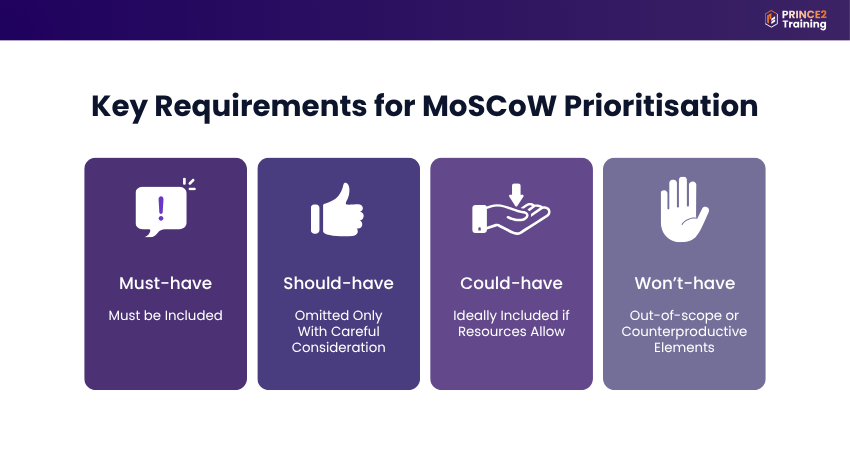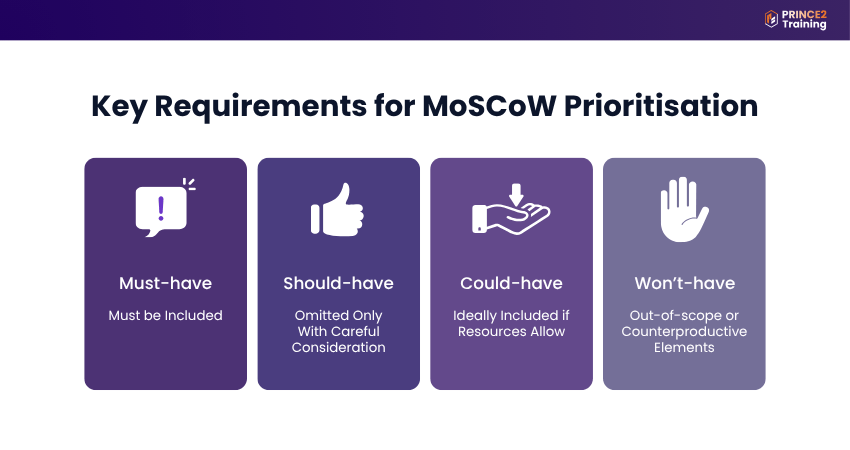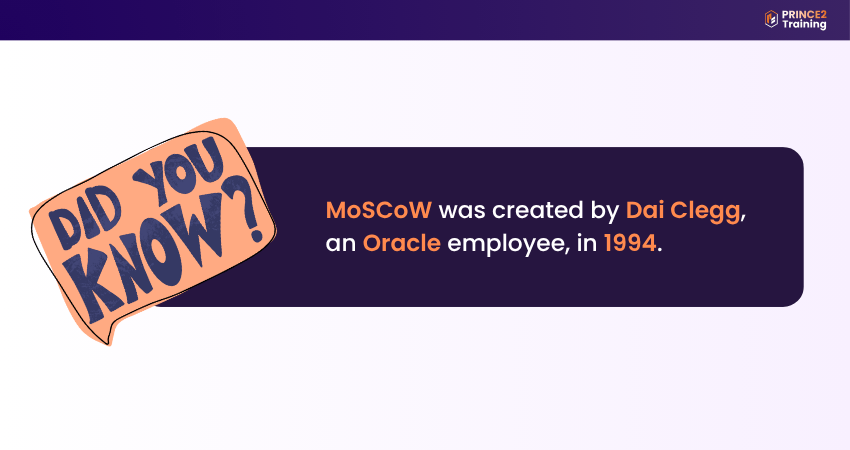Table of Contents

Ever looked at your to-do list and thought, “Everything feels important, where do I start?” You’re not alone! Whether you're planning a project, building a product or organising your day, deciding what comes first can be tough. The MoSCoW Prioritisation method cuts through the confusion by helping you sort what you must do now and what can wait.
In this blog, we’ll explain MoSCoW Prioritisation in a simple and friendly way. You’ll learn what it means, how it works, and how to use it step-by-step. We’ll also look at when to apply it, key benefits, challenges, best practices, real examples and useful tips to prioritise tasks confidently and stay in control.
What is MoSCoW Prioritisation?
The MoSCoW Prioritisation method is a simple way to organise tasks or requirements by importance. It breaks items into four levels: Must-have (essential), Should-have (important but not urgent), Could-have (nice to include), and Won’t-have (not needed now). This method helps teams focus on the most crucial tasks first, making it especially helpful in Agile projects to manage scope and meet key objectives.
By clearly defining priorities, MoSCoW helps prevent scope creep and keeps projects on track. It helps allocate resources effectively and ensures critical tasks are completed before moving on to less important ones. This structured approach improves project outcomes and cultivates clear communication with stakeholders.
How Does MoSCoW Prioritisation Method Work?
Before starting a MoSCoW Analysis, a few key steps need to happen. First, stakeholders and the product team should align on the project’s goals and what factors will determine priority. Next, they need to agree on which tasks to prioritise and how to handle any disagreements that may come up.
Resolving potential conflicts early can keep the project on track. Finally, the team should decide how much time and resources to allocate to each priority level. Once these basics are set, they can begin categorising each task using the MoSCoW method.
1) Balancing MoSCoW Priorities: Ensure each priority level gets the right focus without overloading any category.
2) Defining MoSCoW Prioritisation Categories: Clearly outline what qualifies as Must, Should, Could, and Won’t have.
3) Prioritisation Right Time: Conduct MoSCoW Analysis early in the project to keep everyone aligned from the start.
4) Reviewing Priorities: Regularly revisit priorities to adjust as project needs evolve.
Key Requirements for MoSCoW Prioritisation
As mentioned above, MoSCoW is a simple way to remember four key categories during a prioritisation session. It stands for Must-have, Should-have, Could-have, and Won’t-have, helping teams clearly define task priorities. let's explore each of these categories:

Must-have
a) Must-have initiatives are non-negotiable and essential for the project, product, or release.
b) These tasks are critical for the product to function properly. Without them, the release would be incomplete.
c) Example: In a healthcare app, security features for compliance are considered a must-have to meet regulatory requirements.
d) Questions to consider:
i) What will happen if this initiative is not included in the release?
ii) Is there a simpler way to achieve the same outcome?
iii) Will the product work without it?
e) It is classified as a must-have if the product or release cannot function effectively without it.
Should-have
a) Should-have initiatives are important but not critical to the product, project, or release.
b) The product can still function without these tasks, but they add significant value when included.
c) These tasks can be deferred to a future release without affecting current functionality.
d) Examples of this include performance improvements, minor bug fixes, or new features that improve the user experience.
e) Unlike must-have tasks, should-have initiatives can be scheduled for later without disrupting the main objectives.
Could-have
a) Could-have initiatives are nice-to-have features not essential to the product’s core functionality.
b) Unlike should-have initiatives, they have minimal impact on the overall outcome if not implemented.
c) These tasks are often the first to be deprioritised if must-have or should-have tasks require more time or resources than expected.
d) Could-have initiatives can be included if time and resources allow, but they are not a priority.
e) Examples include minor design tweaks, optional features, or small usability enhancements.
Won’t-have
a) The won’t-have category helps manage expectations by clearly defining what will not be included in the current release or timeframe.
b) It is a key tool for preventing scope creep, ensuring the team stays focused on priority tasks.
c) Assigning initiatives to this category clarifies that they are not priorities for the current period, allowing teams to allocate resources effectively.
d) Some initiatives in this category may be revisited in future releases, while others may be permanently deprioritised.
e) Teams can create subcategories within the won’t-have group to differentiate between postponed and excluded tasks.
Ready to lead Agile teams? Start your PRINCE2 Agile® Foundation Training today!
How to Run a MoSCoW Analysis?
Now that you understand the basics of MoSCoW Prioritisation, you can try it with your team by following these easy steps.
1) Identify and Gather Key Stakeholders
Start by bringing together the main people involved in the project. These may include team members and important decision-makers. It is helpful to have only the right people in the room so the process stays simple and organised.
2) Determine Prioritisation Criteria
Before you decide which tasks to go where, you need to set clear rules for choosing what matters most. Think about what makes a task important, for example, does it help the project work properly, does it support the main goal, or does it solve a major problem for users?
3) Allocate Resources
Think about how much time, money, and effort you can give to each group of tasks. Most resources should go to Must-Have tasks, while Won’t-Have tasks will not receive any. Plan this early so you know what is possible.
4) Define the Timeframe
Choose a clear time period for the work. A shorter time means fewer Must-Have tasks. Check with your project team to make sure the timeline is realistic and everyone agrees. This helps you plan better and avoid rushing tasks later.
5) List Tasks and Requirements
Write down all tasks or ideas before you start sorting them. This helps make sure nothing important is missed. Keeping a clear list also allows everyone to see how and why tasks are chosen.
6) Start Prioritising
Go through the list one task at a time. Decide whether it is a Must-Have, Should-Have, Could-Have, or Won’t-Have. Ask simple questions like, “Do we need this right now?” or “Can this wait?” Some tasks may be hard to place, but talking as a team makes the decision easier.
When Should You Use MoSCoW Prioritisation?
MoSCoW Prioritisation is helpful when you need to decide what tasks to do first and what can wait. It keeps your plan clear and helps you stay organised. You can use it in situations like:
1) Developing New Projects
MoSCoW Prioritisation is very useful when starting a new project. It helps you decide what work must be done first and what can wait. This is especially helpful when time and money are limited, and you need quick progress. With this method, teams can focus on the most important tasks and add other tasks later.
2) Keeping Expectations in Check
MoSCoW Prioritisation also makes sure everyone understands what will be done and what will not. It keeps the team on track and stops people from adding extra tasks at the last minute. This way, there is less confusion, fewer delays, and the project runs smoothly. Everyone knows what to expect and when the work will be finished.
Benefits of MoSCoW Prioritisation
These are the benefits of MoSCoW Prioritisation:

1) Helps Identify What is Most Critical
MoSCoW Prioritisation makes it easy to see which tasks are most important. This way, you start with the tasks that matter the most and cannot be delayed. It helps you stay focused and avoid working on the wrong things first.
2) Aids in Quick, Confident Decisions
Since you know what tasks matter most, the team can focus on them first and avoid spending time on less important work. This makes it easier to make decisions fast without confusion and to keep moving smoothly.
3) Keeps Everyone on the Same Page
Everyone knows what work will happen first and what will come later. This avoids confusion and keeps the team working together smoothly. It also helps people understand what to expect and reduces misunderstandings.
4) Supports Flexible, Goal-focused Work
MoSCoW Prioritisation lets you change plans when needed without losing focus. You can adjust tasks but still work toward the main goal. This makes it easier to handle new ideas or changes without stress and stay organised.
5) Makes Better use of Time and Resources
Time, money, and effort are used in the best way. The team works on the most important tasks first and does not waste time on less important ones. This helps finish important work faster and gives better results.
Limitations and Challenges of MoSCoW Prioritisation
Here are some limitations to keep in mind. Understanding them can help you use the MoSCoW Prioritisation method better.
1) Needs Clear Rules: MoSCoW only works well when everyone knows the rules for choosing tasks.
2) Can be Based on Opinions: Without clear rules, people may choose tasks based on personal views.
3) Need Updates Often: Plans can change, so the priority list may need to be updated many times.
Transform how you manage projects. Sign up for PRINCE2 Agile® Foundation and Practitioner Training today!
Best Practices for MoSCoW Prioritisation
If you’re thinking about using MoSCoW Prioritisation, here are some steps to follow. Adding these steps to your process can help your team get more out of the method.
Use a Clear and Objective Scoring System
a) MoSCoW helps categorise tasks as must-have, should-have, could-have, and won’t-have, but it doesn’t define how to rank them.
b) To effectively assign items to each category, use a separate ranking method.
c) Common ranking methods include:
a) Weighted Scoring: Assigns numerical values based on importance.
b) Value vs Complexity: Evaluates impact versus effort.
c) Kano Model: Focuses on customer satisfaction and expectations.
d) Buy-a-feature: Allocates budget to prioritise features.
e) Opportunity Scoring: Identifies the most impactful tasks based on potential value.
Involve All Key Stakeholders
a) Provide proper context to ensure each initiative is placed in the correct category (must-have, should-have, could-have, won’t-have).
b) Identify stakeholders who can offer valuable insights at the start of the MoSCoW process.
c) Consider input from departments like sales, customer success, executive staff, or Product Managers in other areas.
d) Including diverse perspectives helps identify potential opportunities or threats the team might overlook.
e) Engaging relevant stakeholders ensures a well-rounded prioritisation process and more accurate scoring of initiatives.

Share Your MoSCoW Process Across Your Organisation
a) MoSCoW provides a clear, structured way to show how the team prioritises projects or tasks.
b) It helps build consensus and aligns everyone with the prioritisation strategy.
c) Sharing the methodology with stakeholders sets clear expectations and justifies decision-making processes.
d) When stakeholders understand the criteria behind prioritisation, they are more likely to respect the team’s choices.
e) If stakeholders disagree with a decision, they must be encouraged to present evidence rather than simply raising complaints.
Limit the Number of Must-have Items
Limiting the number of Must-have items ensures that the team stays realistic and focused on what truly matters.
1) It stops the list from becoming too large and overwhelming
2) It makes sure only the most important tasks are chosen first
3) It helps the team finish core work faster and without pressure
4) It keeps expectations clear and avoids treating every task as urgent
Minimum Viable Product (MVP)
Creating an MVP means starting with the simplest version of the product that still works and gives value.
It helps you launch faster without waiting for every feature
You can test the product early and learn from real users
It saves time and effort by avoiding work on extra features too soon
It lets you improve step-by-step based on feedback
Review and Adjust Priorities Regularly
Checking and updating priorities often helps keep the project on the right track.
It makes sure tasks match current needs and goals
It helps you respond quickly if plans or situations change
It stops old or less important tasks from taking up time
It keeps the team clear, focused, and working in the right direction
Build strong fundamentals in project leadership. Join our PRINCE2® Foundation Training today!
Real-world Examples of MoSCoW Prioritisation in Action
These three examples will help you fully grasp the concept of MoSCoW Prioritisation:
1) Prioritising Features for a New Mobile App
A startup is developing a new mobile application and needs to determine which features to include in the initial launch.
a) Must-have: User authentication (login and signup), core functionality (e.g., messaging or content browsing) and data security measures.
b) Should-have: Push notifications, user profile customisation and in-app search functionality.
c) Could-have: Dark mode, integration with third-party services and advanced analytics for users.
d) Won’t-have: Augmented reality features and extensive social sharing options for future updates.
2) Organising Tasks for a Marketing Campaign
A marketing team is planning a campaign for a product launch and needs to prioritise tasks effectively.
a) Must-have: Create promotional content, schedule launch events and coordinate with sales teams.
b) Should-have: Engagement with influencers, development of email marketing sequences and preparation of press releases.
c) Could-have: Hosting webinars, creating behind-the-scenes content and running contests or giveaways.
d) Won’t-have: Developing a podcast series or launching a merchandise line for future campaigns.
3) Managing IT Infrastructure Upgrades
An IT department is upgrading its infrastructure and must prioritise various initiatives.
a) Must-have: Upgrading servers that are at capacity, implementing critical security patches and making sure data backup systems are operational.
b) Should-have: Migrating to a new email platform, updating internal communication tools, and enhancing network monitoring capabilities.
c) Could-have: Introducing new collaboration software, optimising existing workflows, and training sessions for staff on new tools.
d) Won’t-have: Exploring experimental technologies or overhauling systems that are functioning adequately to be revisited in the next fiscal year.
Tips for Prioritising Effectively with the MoSCoW Framework
Here are some easy tips for using MoSCoW Prioritisation framework:
a) Include Key People: Make sure important team members are involved, so everyone agrees on priorities.
b) Use facts, not Guesses: Choose tasks based on real needs or clear information, not just opinions.
c) Stay Flexible: Be ready to change priorities if the project needs to be changed.
Conclusion
MoSCoW Prioritisation helps you decide what tasks are most important and what can wait. It makes planning easier, keeps teams focused, and helps projects run smoothly. By using this method, you can finish the most important work first and avoid stress or confusion. With a little practice, it becomes a clear and helpful way to manage any project or daily tasks.
Ready to lead projects with confidence? Get your PRINCE2® Certification now!




 Back
Back


 Back to
topics
Back to
topics









